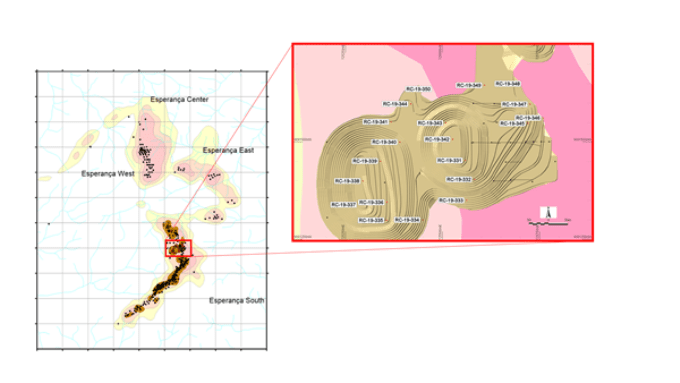Nov 22 2019
TriStar Gold Inc. has reported the first results from the drilling operation currently in progress at its Castelo de Sonhos gold project. This operation aims to boost confidence in Mineral Resources in the Esperança South region of the project for Mineral Reserve calculations in the pre-feasibility study.
 Drill plan for Esperança South, highlighting locations of drill holes discussed in this press release. Blow-up showing detailed locations of reported drill holes. New holes are drilled vertically to a maximum targeted depth of 120 m. Image Credit: Tristar Gold Inc.
Drill plan for Esperança South, highlighting locations of drill holes discussed in this press release. Blow-up showing detailed locations of reported drill holes. New holes are drilled vertically to a maximum targeted depth of 120 m. Image Credit: Tristar Gold Inc.
The assay laboratory has currently released the results for 20 of the reverse-circulation (RC) drill holes (out of a scheduled total of about 200 holes); all of these are situated on eight neighboring section lines spaced 50 m apart. The results are as follows:
- 24 m @ 1.1 g/ton from 95 to 119 m in RC-19-342
- 14 m @ 1.2 g/ton from 36 to 50 m in RC-19-347
- 1 m @ 17.9 g/ton from 51 to 52 m downhole in RC-19-345
True widths are about 90% of the downhole lengths stated above.
TriStar constantly tracks drill results by assessing whether they match expectations from earlier drill holes nearby, surpass expectations, or do not match expectations. Out of the holes for which the assays have currently been reported, 90% of them match or surpass expectations, with nine of them exhibiting assays consistent with what has already been seen in adjacent drilling, and nine of them exhibiting assays that are markedly better than anticipated.
TriStar is carrying out sequential drilling of the holes, with the objective of first gathering information from holes whose results will help decide whether or not other holes must be drilled. On the seven section lines which the first group of holes covers, there are 18 potential hole locations for which drilling is dependent on the results of previous drilling.
The early assay results are adequately positive that 15 of these contingent holes will currently be drilled; decisions on the other three await assay information, which is yet to be received.
We are very pleased with these early results. They’re coming in as-good-as or better-than we expected. And we’re pleased that our sequencing of the drilling is helping us with cost control, generating early information that allows us to make smarter decisions about hole locations later in the campaign.
Nick Appleyard, President and CEO, TriStar Gold Inc.
Appleyard continued, “This is a very encouraging start to the infill program that will lead to the prefeasibility study aimed at taking the CDS Project, for the first time, from resources to reserves.”
Drilling
Comprehensive summaries of drill hole locations and major intervals have been added to the CDS project page of the company website (www.tristargold.com).
Assay Methods, Quality Assurance and Quality Control (QA/QC)
All drill hole samples are examined using a fire assay analysis of the chips taken from RC holes. Any sample that yields more than 0.1 g/t gold is automatically sent for a duplicate fire assay analysis, and the average grade is used. Samples are conveyed from the site to the ALS preparation lab in Goiania, Brazil, by truck. There, they are dried, crushed, pulverized, and packaged for delivery to the ALS analytical lab in Lima, Peru.
The ALS preparation and analytical labs, which are accredited to ISO 17025:2005 UKAS ref 4028, have internal QA/QC programs for accuracy and precision monitoring. Besides this, TriStar uses standards, field duplicates, and blanks in an external QA/QC program to enable autonomous monitoring of laboratory analyses.